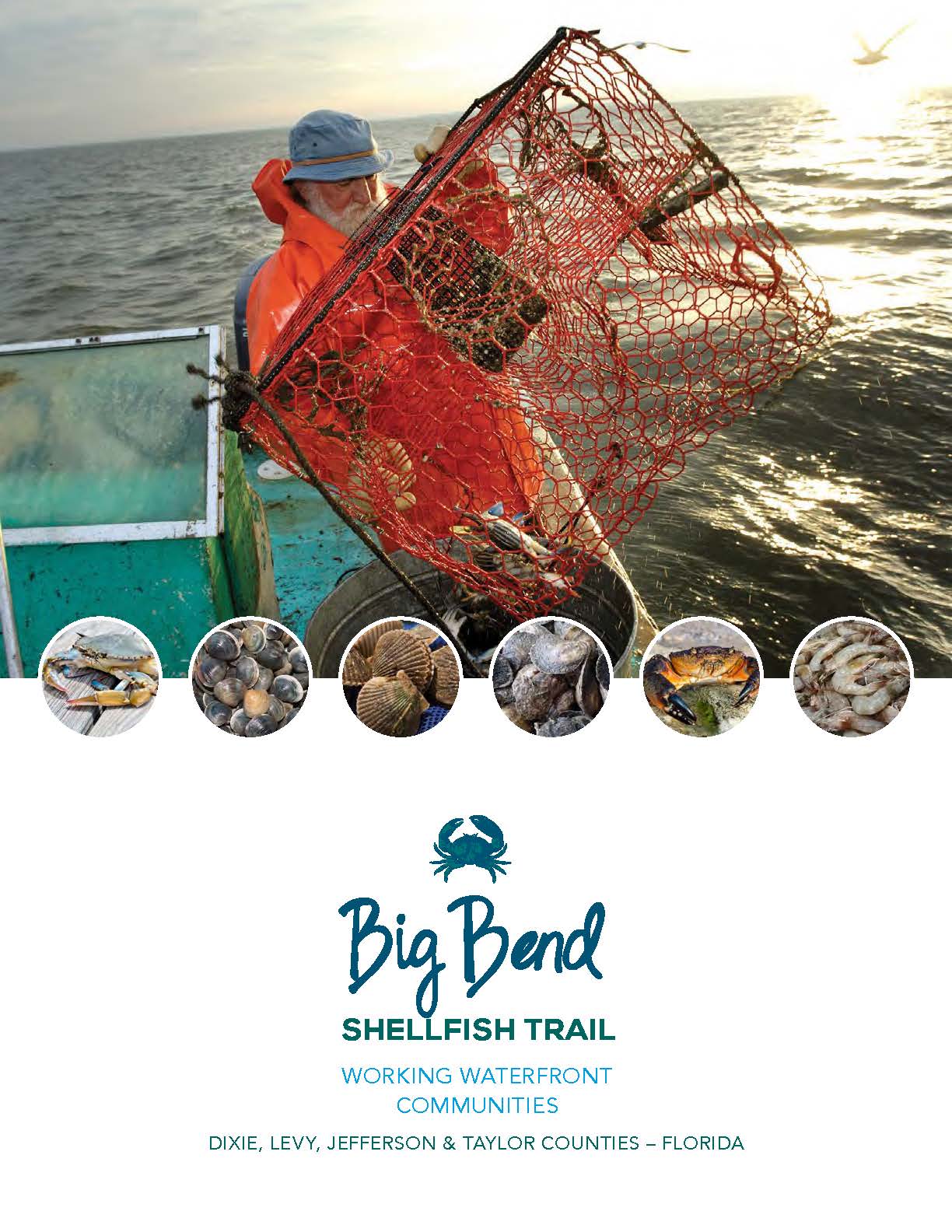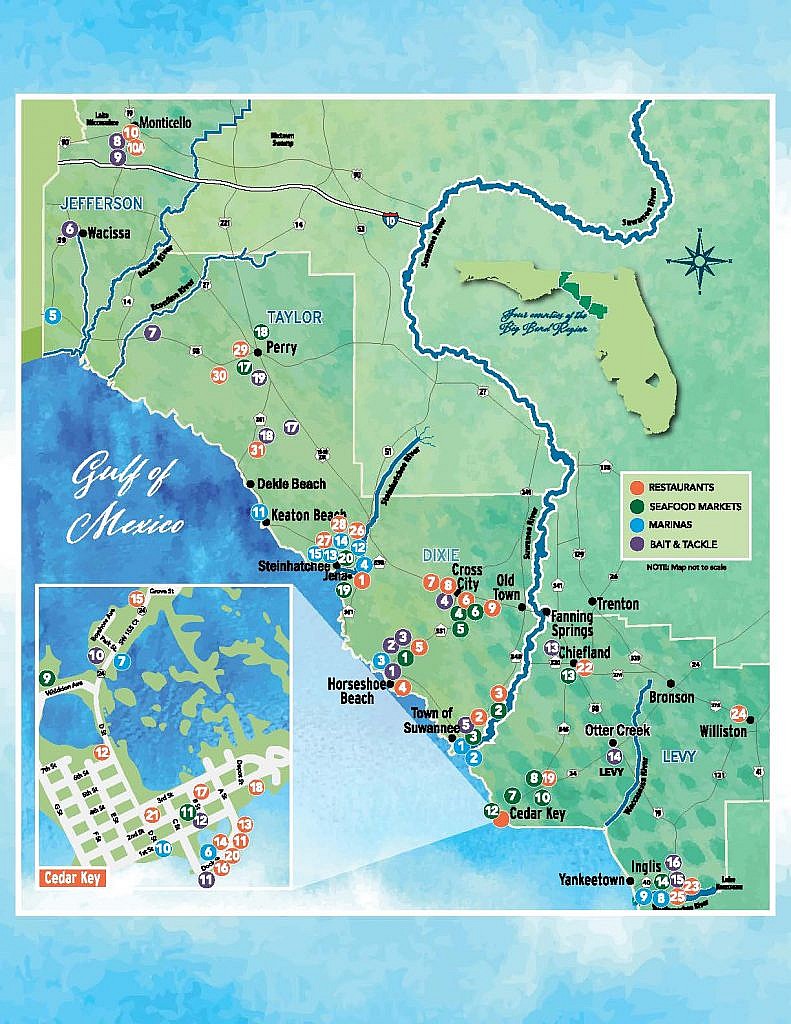Big Bend Shellfish Trail–Florida’s Working Waterfront Communities


Shellfish harvest and consumption in Florida is an important facet of the maritime heritage of many coastal towns. Natural North Florida’s Big Bend has several towns that still harbor local shellfish fisheries. These working waterfront communities are places where present day fishers carry on the traditions of past generations. The Big Bend Shellfish Trail Map is an exciting new resource visitors and residents can use to learn about shellfish and the fisheries they support. A printable version of the map and brochure is available for download at:
https://www.dropbox.com/s/vks1lbay50d7lhh/ShellfishTrailMap_web.pdf?dl=0
The Big Bend Shellfish Trail offers an immersive experience, encouraging visitors to appreciate the ecological setting that supports shellfish and learn about the historic places along the trail. The Trail map highlights six shellfish species: oyster, hard clam, bay scallop, blue crab, stone crab, and shrimp. These six fisheries each have their own nuanced history in the Florida Big Bend region and there is much for visitors to discover as they trek along the Big Bend Shellfish Trail.
There is so much to learn and discover about shellfish fisheries in the Florida Big Bend! Some of the things to look for and ask about on your journey down the Trail include:
1) Native American history – Keep an eye out for large shell middens, evidence of the huge importance of shellfish to the Native American diet. These middens are scattered throughout the Big Bend coastline.
2) A healthy environment – Shellfish require healthy coastal systems with clean waters. Whether it’s the seagrass meadows that support bay scallops or the Suwannee Estuary that supports oysters and clams, there is always a link between the quality of local seafood and the quality of the local environment. Find out what you can do to help protect the coastal environments of the Big Bend!
The Big Bend is one of the least developed and most sparsely populated regions of Florida. Extensive seagrass meadows and expansive salt marshes still thrive in the Big Bend. These and other habitats support a huge diversity of fisheries, including highly productive shellfish fisheries. Florida’s Gulf Coast, in general, is a vital part of statewide shellfish fisheries, supporting ~97% of commercial oyster harvest and ~73% of the commercial blue crab harvest in Florida according to recent USGS and FWC reports. In addition, recreational and commercial harvest of stone crabs, recreational harvest of bay scallops, and aquaculture of hard clams are important aspects of present day maritime economies.
3) The Seahorse Key Lighthouse – this pre-Civil War lighthouse was important for fisheries and shipping of locally produced products and helped make Cedar Key a major port in the late 1800s. The lighthouse was operational from August 1, 1854 to 1915 except during the Civil War years.
4) Shellfish harvesting techniques/gear – from lower-impact methods such as tonging, traps/pots, and hand capture to modern and sometimes higher-impact methods such as trawling, dredging, and mechanical harvest, shellfish are harvested many different ways. Each of these methods have different impacts on fishery resources. Present-day harvest techniques are connected to long histories of resource exploitation in each of the different fisheries.
5) Shellfish harvesting vessels – special modifications are often needed to accommodate the various gear and water conditions encountered when harvesting different types of shellfish. The history and culture of these innovative modifications, such as the “bird dog boat”, are important aspects of maritime heritage. Many of these modifications can be observed on existing vessels along the working waterfronts of the Florida Big Bend – which ones will you find?
6) Commercial and recreational fisheries – some shellfish fisheries were historically only commercial in nature while others had a recreational component since their inception. Certain shellfish fisheries, like the bay scallop fishery, are now restricted only to recreational harvest. New commercial shellfisheries, like the hard clam fishery, have arisen because of technological advances in aquaculture. The history of fishery management, development, and regulation and the culture surrounding the commercial and recreational sectors of these fisheries are some of the most fascinating untold stories of shellfish fisheries “then and now”.
7) “Boom and Bust” – Cycles of good times and bad times are common in coastal fishing towns. Booms and busts can be brought on by natural fluctuations in the resource, natural disasters, human impacts to the fisheries resources, or other factors such as the Civil War or competition from imported seafood. Whatever the reasons, the coastal residents of the Florida Big Bend have found innovative ways to adapt to the many challenges that have faced them, both natural and man-made.
8) Packing of seafood products – seafood processing and packing houses are important facets of the shellfish industry nationwide. The seafood packing industry has undergone many changes over time in response to advances in technology, such as the advent of refrigeration, and changes in the economic and regulatory climates. There are very few processing facilities left in the Big Bend but the ones that remain, such as Southern Cross Sea Farms in Cedar Key, offer a fascinating look inside the seafood industry.
9) Shipping and transport of seafood products – the major shipping port of Cedar Key, the steamboat shipping industry of the Suwannee River, and the Florida Railroad were all avenues by which shellfish from the Big Bend were historically transported to inland Florida and other locations. The shipping industry has disappeared from the region but historical remnants of the once thriving commerce of the region can still be observed and appreciated at destinations such as the historic City of Hawkinsville steamboat wreck in the Dixie County reaches of the Suwannee River.
10) Traditional seafood preparation – the culinary traditions of shellfish preparation and enjoyment are some of the richest in the United States, with many shellfish taking on a decidedly regional or locally discernible flavor. There are many points along the Big Bend Shellfish Trail where visitors can enjoy locally sourced shellfish, often prepared using traditional recipes. The ability to experience the sights, smells, and flavors of local seafood is one of the most exciting aspects of the Trail!
Share your Shellfish Trail discoveries on social media using the hashtag #FloridaShellfishTrail
Thanks to the following for the information included in this post:
UF/IFAS Nature Coast Biological Station
Florida Fish and Wildlife Conservation Commission

